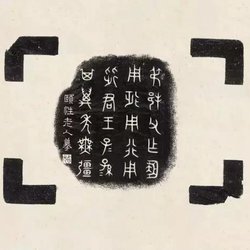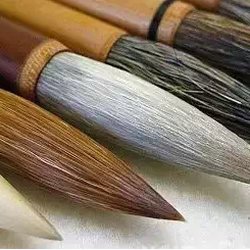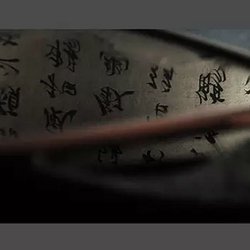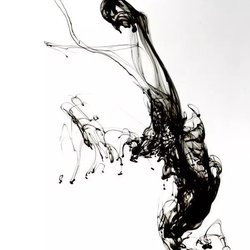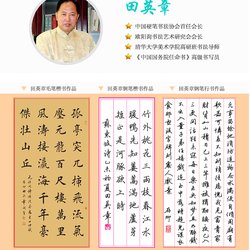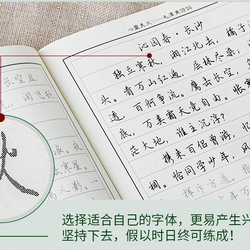Duan inkstone is the first of the four famous inkstones in China. It has been praised by literati of all ages for its excellent ink-generating properties. However, nowadays, few people mention the practical value of Duan Inkstone. The reason is very simple: fewer and fewer people use it. When Duan Inkstone became a kind of art and collection, people naturally shifted their focus to the rich stone patterns and delicate carvings.
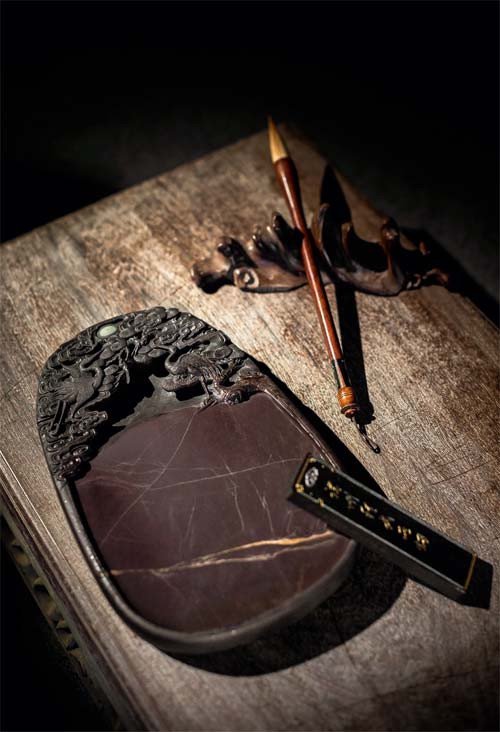
Zhaoqing, the capital of inkstones, naturally everything you think about when you come here is related to inkstones. Even the lake water wrinkled by the morning breeze and the towering Seven Star Rocks in front of you can't help but think of a famous inkstone handed down from generation to generation: Su Shi's "Su Shi" who is now collected in the National Palace Museum in Taipei. From Xingyan". On this square inkstone, there is a stone eye protruding like the moon in the inkstone, with a few simple strokes of flowing clouds carved under it. On the back of the inkstone, there are more than 60 stone pillars, high and low. There are stone eyes on the top of the pillars. When you turn it over, it looks like stars falling. There is Su Shi's inscription engraved on the side of the inkstone: "The moon follows the stars, and there is wind and rain. The vast ocean of calligraphy and ink, this is like it. Black clouds float in the sky, and the sky is invisible. The wind blows and the clouds move, and the stars and the moon are awe-inspiring."
"Shang Shu·Hong Fan" says: "When the moon follows the stars, it is caused by wind and rain." It means that when the moon moves to a certain position of the stars, wind or rain will occur. Su Shi used this allusion as a metaphor to fill the empty space with wind and rain. The ink pool is likened to the sky covered by dark clouds, and after the ink is used up, like the wind and clouds moving, the stars and moon are clearly revealed again. The stars and moon in Su Shi's imagination are the unique stone eyes of Duan Inkstone, a pattern with multiple colored halos.
In the Song Dynasty, Duan Inkstone evolved from a simple study utensil into an artistic treasure that is both practical and ornamental.
Duan stones are mostly purple, which is called "purple jade". They are as warm and moist as jade, which is quite impressive. The colorful stone patterns that occasionally appear on it make the imaginative literati and poets sway with their hearts and imagination.
For example, a pattern that is white with a hint of greenish-yellow and stretched like a young banana leaf is called "banana leaf white"; a pattern that is as loose as a clear cloud is called "floating cloud jelly" or "fish brain jelly" ; If the color is close to the sky before dawn, dark blue with a hint of gray, it is called "Azure", which is a rare stone pattern. If "Azure" is topped with "Floating Clouds", it will be even rarer. The names of these stone patterns, which are as beautiful as poetry, can only jump out of the minds of literati after they observe and play with them day after day.
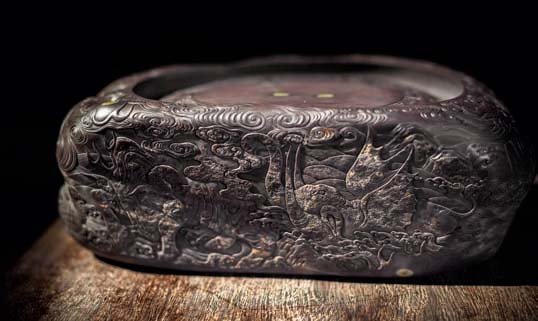
For inkstone masters, in order to properly express these rare stone patterns, they need to look at the uncarved inkstones every day without getting tired of looking at them. He said: "The stone will tell you what to do." Inkstone master Cheng Lao was born in a Duan inkstone family in Baishi Village, Huanggang Town, Zhaoqing City. He started learning to make inkstones at the age of thirteen and never left Duanshi and carving knives for a day. Like all excellent ink stone masters, Lao Cheng also emphasizes applying his skills according to the material's materials, and designs patterns according to the stone texture.
It’s easy not to use the knife until you come up with the most suitable pattern. Some stones can even sit for four or five years until inspiration strikes.
Lao Cheng said that when comparing inkstones, the Japanese would put the inkstone into a wooden basin, fill it with water just enough to cover the inkstone hall, and place it under the slanting sunlight in the early morning or evening, so that the patterns on the stone can be clearly displayed one by one. We looked at the inkstones in Lao Cheng's Duan Inkstone Shop. Although it was not as complicated as the Japanese, we would also wipe it with a damp cloth. The pattern we obtained in this way was indeed more vivid and moist, and every detail was revealed.
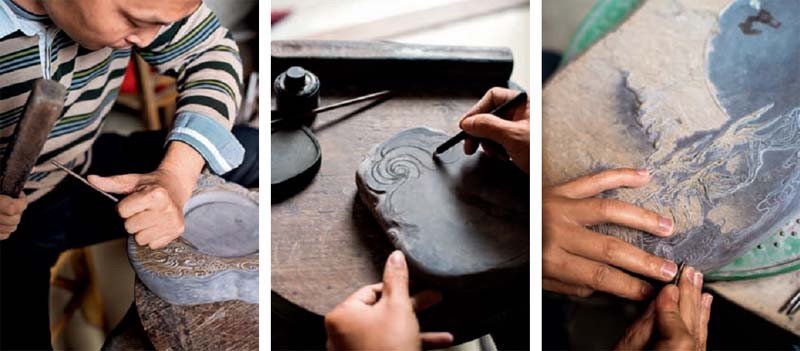
The end stone for making inkstones is "born in the spring", and its appearance in the water is closer to its natural state. Zhaoqing was called Duanzhou in ancient times, and a section of the Xijiang River flowing through Duanzhou was called "Duanxi" in ancient times. It is this river that has been flowing for thousands of years that gave birth to the smooth and moist end stones. However, not all stones collected along the river can be used to make Duan inkstones. Only a few stone veins buried deep in the ground are the treasures that form inkstones. Generations of inkstone workers dug deep along the stone veins, forming secret and deep pits. Among them, the one with the best stone quality is located in Xuke Mountain on the south bank of Antelope Gorge, which is what inkstone masters and collectors cherish. Three famous pits: Laokeng, Hangziyan and Mazikeng.
Antelope Gorge is ten kilometers east of Zhaoqing city. Su Shi was relegated from Huizhou, Lingnan, to Danzhou, Hainan. When he passed the Antelope Gorge, he witnessed the difficult scene of mining inkstones at that time. He was touched and wrote: " Thousands of people pull the rope, and hundreds of people carry the heavy weight. They lower it under the bonfire to bring out the treasure." ("Duan Yan Inscription") In order to obtain this precious stone, thousands of people are required to hold buckets and ropes to draw water, and hundreds of people are wielding axes and chisels, lifting Toiling in the pit with torches.
Hang Tsai Rock is located on the mountainside about 200 meters away from Laokeng. It belongs to the same stone vein as Laokeng. Below the pit entrance, one to two hundred meters of gravel were scattered, which were damaged stones that had been excavated from the cave over many years. Next to the old pit, a stream gurgled. Along this creek, go upstream and go deeper, you can see the pockmark pit. It was named after it was discovered by a pockmarked man named Chen in the Qing Dynasty.
When did people here start risking their lives to quarry? No one can tell now. There is evidence that Duan Inkstone was favored by literati as late as the early Tang Dynasty. Ji Nan of the Qing Dynasty said in "Shi Yin Inkstone Talk": "Dongpo Yun, Duanxi Stone, originated in the Wude era of the Tang Dynasty." At first, people did not pay special attention to the patterns and carvings on inkstones. Duan inkstones in the Tang Dynasty were simply "skip-shaped" "Inkstone", even in the Song Dynasty, although the appreciation of Duan Inkstone has been valued, practicality is placed first. Even the "stone idiot" Mi Fu said quite soberly: "Utensils are based on their use... The stone is made of ink first, the color is second, and the shape and workmanship are second."
Literati and calligraphers do not like the inkstone to produce ink quickly. Too fast means that the inkstone is rough and the quality of the ink produced is often rough. The ink produced by the Duan inkstone is neither fast nor slow, and the ink is fine and even, like oil. And because Duanshi is nourished by spring water all year round, the stone is cool and moist, so it can not dry up in summer and not freeze in winter.
From the Song Dynasty to the Qing Dynasty, literati of all dynasties praised the excellent ink-generating properties of Duan Inkstone in their poems and articles. However, in modern times, the practical value of Duan inkstones is rarely mentioned. The reason is very simple. Fewer and fewer people use inkstones. Moreover, since the pits were closed, the value of Duan inkstones has skyrocketed. Especially in Laokeng, one inkstone costs dozens or hundreds. Ten thousand yuan, who is willing to use it to polish pens and ink? When Duan Inkstone became a kind of art and collection, people naturally shifted their focus to the rich stone patterns and delicate carvings.
Before leaving Zhaoqing, we also visited Cheng Zhenliang’s uncle, Mr. Cheng Wen, a respected inkstone master. He is a respected elder in Baishi Village and has been making inkstones for more than half a century. The old gentleman suffered a serious illness the year before last, and now the hand holding the cigarette can't help but shake. However, he still can't let go of the carving knife, and he still has to carve for an hour or two every day. In his opinion, no matter whether there are old or new pits, whether there are stone patterns or not, as long as it falls into your hands, it is a good stone. "Following the shape of the stone" is a basic principle of this industry. Carving an ordinary stone into a spiritual aura , Carving out the "inkstone flavor" is the key. When Cheng Wen held the carving knife in his hand, he was like a child focusing on the toy in his hand. His trembling right hand became firm and steady, and he moved the knife on the hard inkstone as leisurely as if he were strolling in a garden. With a piece of inkstone in his hand, the Motang inkstone pool gradually took shape, and the seawater cliffs, turtles and black birds gradually came to life. When the stone fragments blew away, the fragrance of ink seemed to have been added to the nose.
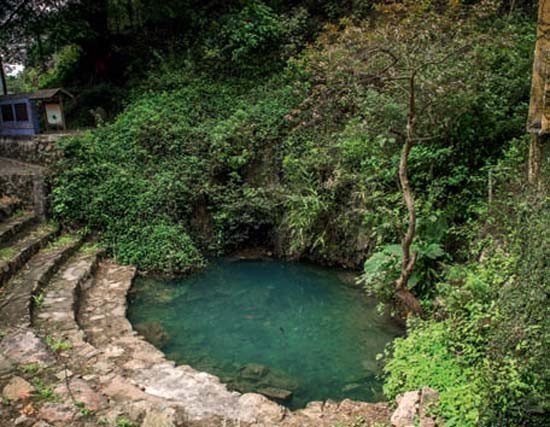
In order to protect the non-renewable rare inkstones, Huke Mountain has been sealed by the Zhaoqing Municipal Government for many years. The picture shows the old pit at the foot of the mountain, which has now become a pool of blue waves. An iron gate under the water seals the entrance of the pit, and a few swimming fish hint at the quiet and long years. In the past, to quarry inkstones in Laokeng, you had to wait for the dry season and use wooden barrels to constantly transport the water out of the cave. The mouth of the pit is more than 200 meters down. You can imagine how difficult it is to quarry. Because the inkstones in the old pit have been soaked in water all year round, they are particularly delicate and tender, with the best texture.

